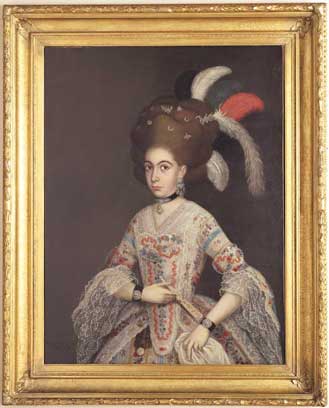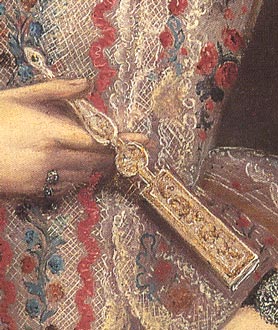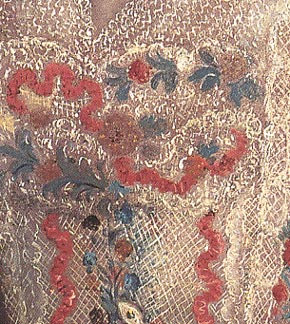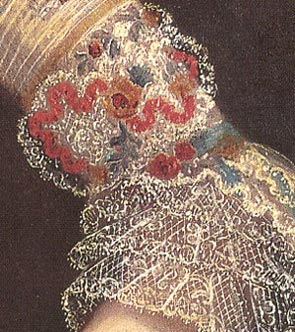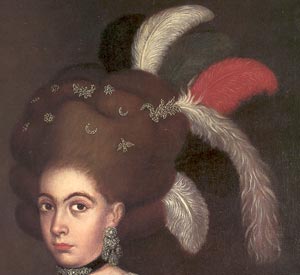
Portrait of a Lady, 1782
Students begin by answering the questions from the criteria. The teacher may provide some information given below if needed, but clues from the picture should provide most of the information.
Information about this portrait:
New Spain enjoyed immense wealth in the seventeen hundreds, from land, from silver, and from international trade. The upper classes liked to display their wealth in lavish lifestyles. This lady's elaborate appearance was the epitome of wealthy excess in 1782, when her portrait was painted.
Her towering hairdo is decorated with diamonds and feathers. Her embroidered clothing is trimmed with yards of expensive imported lace. Her ears, neck, and wrists are ornamented with jewelry.
Notice the fan she holds at her waist, many Viceregal ladies owned vast collections of them. They belonged to a secret language of signs for sending coded messages to suitors. A man's hopes could rise or fall depending on whether a lady left a fan lying around, closed it sharply, or held it halfway open.
Ladies like this played a central role in New Spain's social fabric. While these women definitely were more sheltered than most other women, either the mixed-race, indigenous or lower-class Spanish women who lived there, we shouldn't assume that they had no social lives or influence. For one thing, traveler accounts as well as personal correspondence from the 18th century shows that elite women participated in a social life that included family, friends and compadres or ritual kin who were important in the family lives of Spaniards throughout New Spain. They visited each other in each other's homes, they played cards together, they often attended privately held musical performances or plays, sometimes even discussion groups.
They had less say over who they were married to because their marriages were used to create, cement or further family and kinship alliances. The women of the wealthiest families brought astonishingly large, very lavish dowries, which included money, but also included land, furniture, silverware, jewelry, luxurious clothing -- even slaves.
Historical Information relevant to this portrait:
Fans
By the 15th and 16th centuries, Chinese artists began making folding fans. Previously Chinese fans were stiff circles or made of feathers. These folding fans were about 12 inches to 14 inches long, including the ribs and more than half the surface was covered by the mounted paper. The 18th and 19th centuries in China saw the production of fans solely for the export market. These fans were made by the Chinese to cater for 'barbarian' tastes and were not used by the Chinese themselves.
The first folding fans were reserved for Royalty and the nobility and, as expensive toys, they were regarded as a status symbol. Whiles their "montures" (i.e. sticks and guards) were made from materials such as ivory, mother of pearl and tortoiseshell, often carved and pierced and ornamented with silver, gold and precious stones, the leaves were well painted by craftsmen who gradually amalgamated into guilds.
For more information:
- The Fan Museum: The History of the Fan
http://www.fan-museum.org/history.htm- The Worshipful Company of Fan Makers: Gallery of Fans
http://www.fancircleinternational.org/- International Fan Collectors Guild
http://www.hand-fan.org/- The Costumers' Manifesto: 18th Century Fans
http://www.costumes.org/pages/18thfans.htmClothing
During the 1700s fashionable women around the world wore a number of petticoats and a lace- trimmed bodice that resembled a corset. This bodice was laced in front and back and contained whalebone stays. Many of the homes of the rich contained extra wide doorways and stairways to accommodate the six-foot hoop skirts and petticoats. Women's shoes had high heels and the extremely coiffured hairstyles were designed to make them appear taller.For more information:
- The Cut of Women's Clothes 1700-1800
http://www.costumes.org/pages/18thwomenscut.htm
Hair and Feathers
Close to the head styles of hair were prevalent until 1760 when the coiffure gradually begun to rise with the aid of hair pads and pomade made from apples, lard, and floral oils.
Hairstyles continued to rise steadily until 1778 when high fashion was achieved by as much as three feet of hair above the head surmounted by an elaborate headdress, of fabric, feathers, flowers and pearls. It is a tribute to the influence of French fashion which was to dominate European style from the 17th to the mid 20th century, and its prestige derived from the glamour of Versailles and the influence of Louis XIV.
For more information:
- The Costumers' Manifesto: 18th Century Women's Hair and Wigs
http://www.costumes.org/pages/18thhairwomen.htm- Georgian Timeline of Fashion and Events
http://romancereaderatheart.com/georgian/timeline/
Diamonds
The first river-bed (alluvial) diamonds were probably discovered in India, in around 800 B.C. The volcanic source of these diamonds was never discovered, but the alluvial deposits were rich enough to supply most of the world's diamonds until the eighteenth century, when dwindling Indian supplies probably spurred the exploration that led to the discovery of diamonds in Brazil in 1725 in a town 300 miles north of Rio de Janeiro which is now called Diamantina, which became the next important diamond source. From 1730 to 1870 Brazil was the world's major source of diamonds.In the 18th century the diamond soared to new heights and abundance in jewelry, and was worn principally by women. Substantial quantities of diamonds were now arriving from South America, and made the conspicuous display of the gem possible. The jewelry is breathtakingly elegant, revealing the full beauty of the rose- and brilliant-cut stones. Claws hold the stones in silver settings, which from the 1760s are backed with gold to avoid tarnishing the wearer's skin and dress. Diamonds were reserved for evening since it was considered vulgar to parade them by day. Rather than a miscellany of jewels of different types, a parure -- a matched set of jewelry -- was now worn at all important social events.
For more information:
- The American Museum of Natural History: The Nature of Diamonds
http://www.amnh.org/exhibitions/diamonds/name.html
